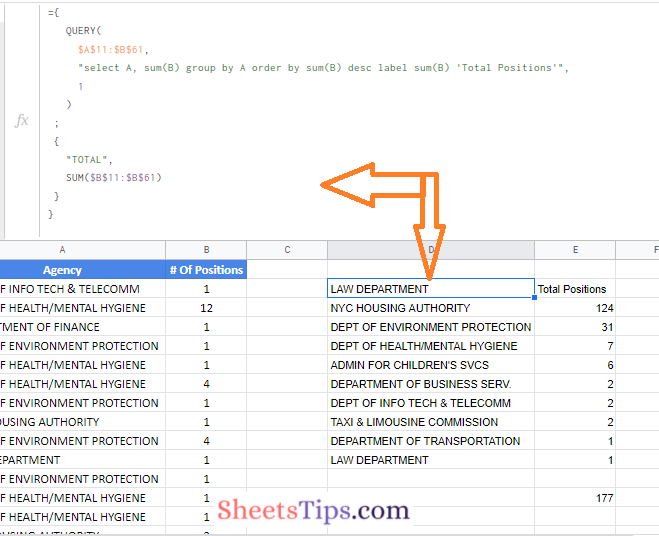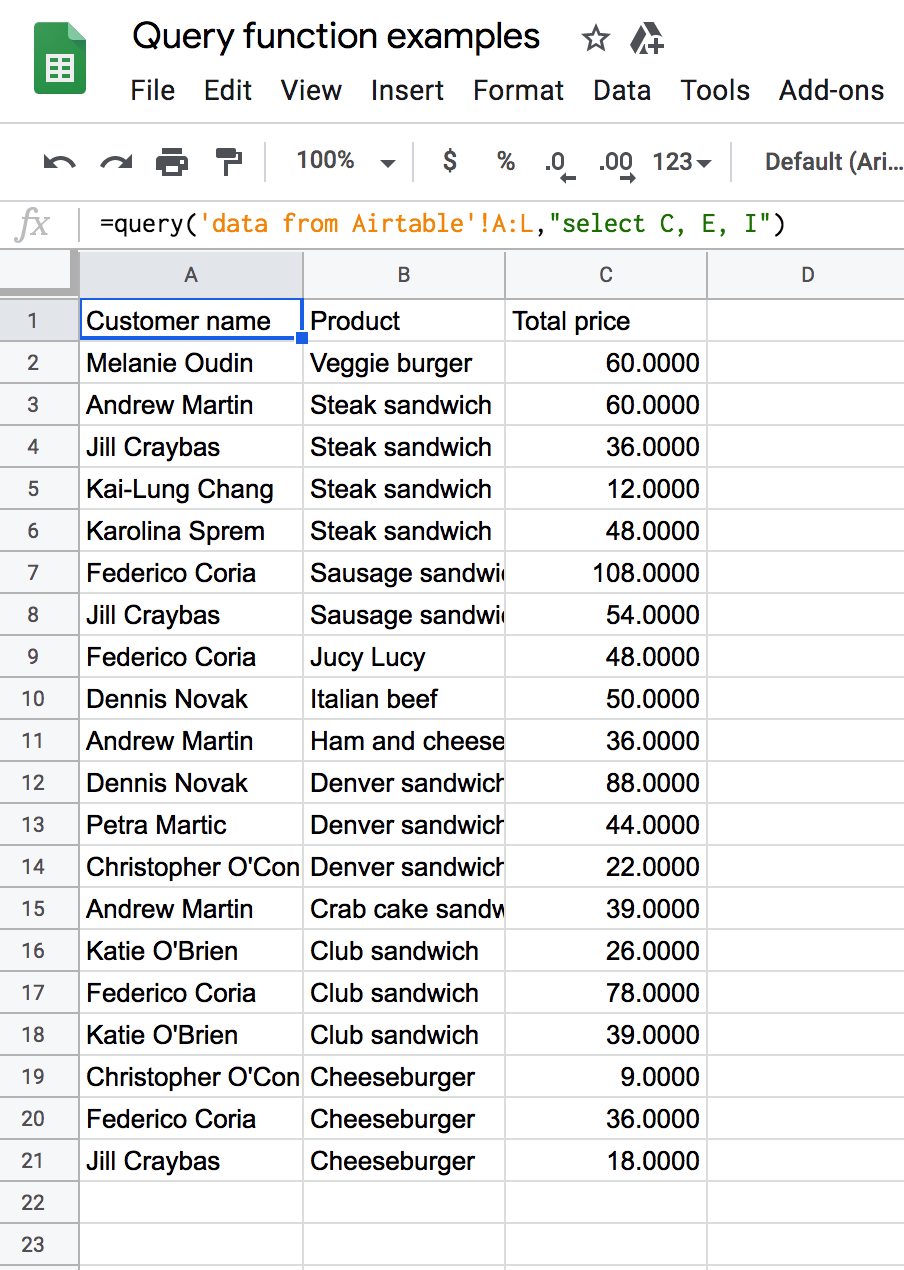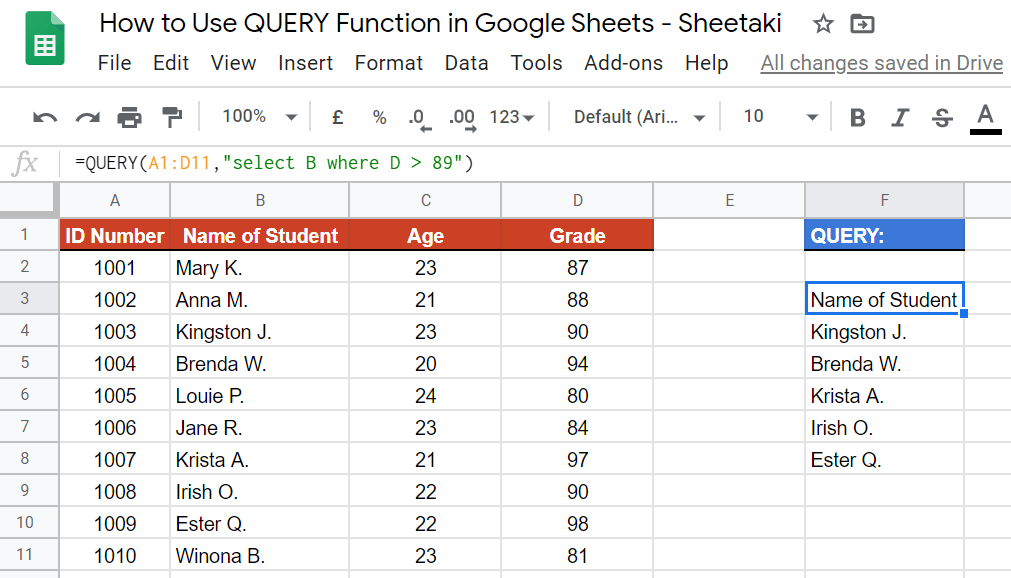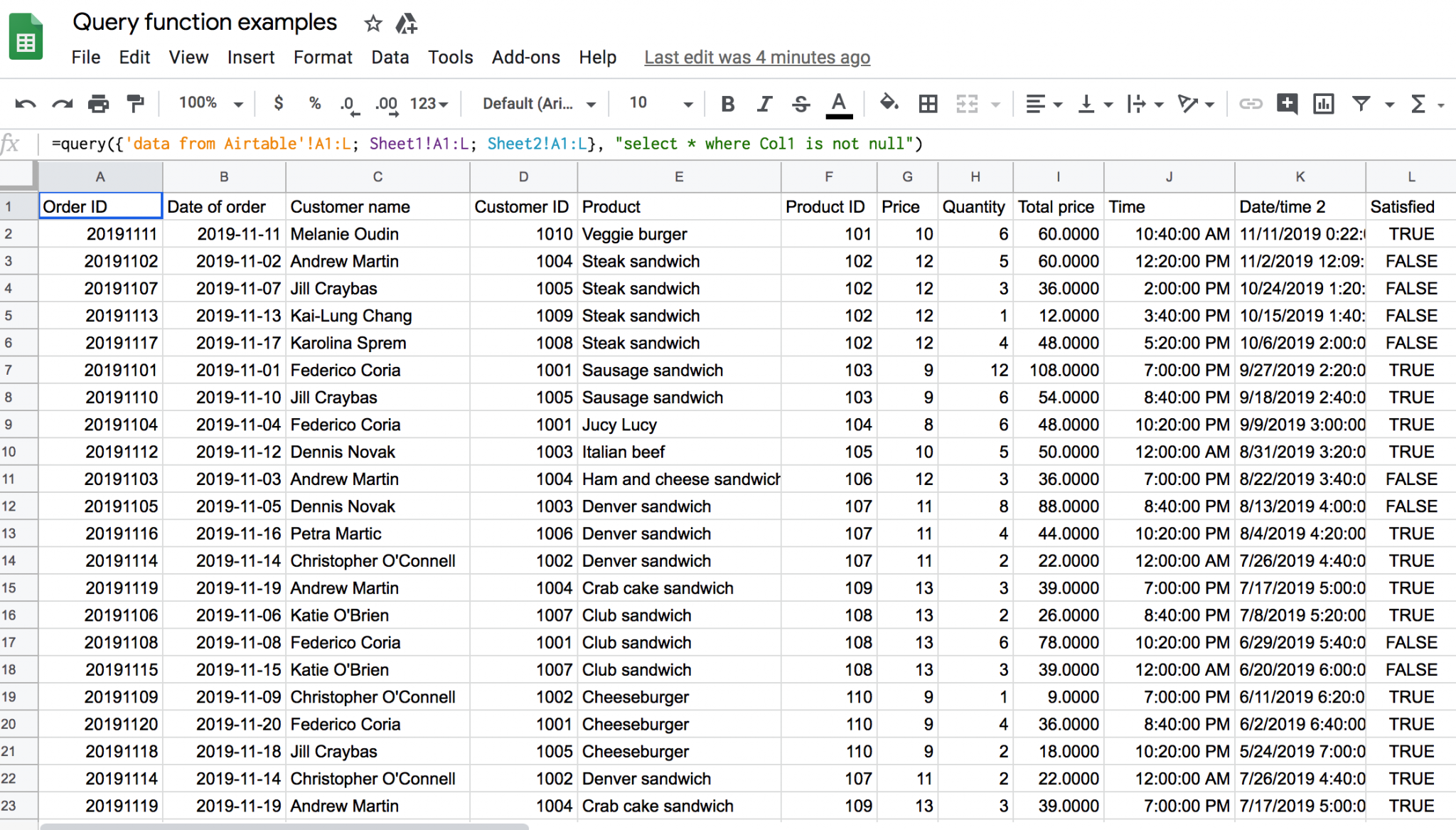
How To Use Google Sheets QUERY Function
You can use the SUM() function in a Google Sheets query to find the sum of values in rows that meet certain conditions. Method 1: Sum All Rows = QUERY (A1:C13, " select sum(C) ") Method 2: Sum Rows that Meet One Criteria = QUERY (A1:C13, " select sum(C) where B>100 ") Method 3: Sum Rows that Meet Multiple Criteria

How to Use QUERY Function in Google Sheets [StepByStep]
How to sum and group values by a certain condition in Google Sheets: QUERY+SUM. Here is an alternative solution to the SUMIF formula above. The idea is to extract unique values from the Product column and return the total amount of each product with a single formula. The QUERY function can easily do that as follows:

How to use the Google Sheets QUERY formula Sheetgo Blog
The format of a formula that uses the QUERY function is. =QUERY (data, query, headers) . You replace "data" with your cell range (for example, "A2:D12" or "A:D"), and "query" with your search query. The optional "headers" argument sets the number of header rows to include at the top of your data range.

Google Sheets Query Honest Guide with Formulas and Examples Coupler.io Blog
You can use the SUM () function in a Google Sheets query to find the sum of values in rows that meet certain conditions. Method 1: Sum All Rows =QUERY(A1:C13, "select sum (C)") Method 2: Sum Rows that Meet One Criteria =QUERY(A1:C13, "select sum (C) where B>100") Method 3: Sum Rows that Meet Multiple Criteria

How to Use QUERY Function in Google Sheets [StepByStep]
October 27, 2018 18 There are aggregation functions equivalent to Sum, Average, Count, Max, and Min in Google Sheets Query. What are they? They are sum (), avg (), count (), max (), and min (). One must know how to use aggregation in Google Sheets Query to manipulate data properly.

How To Add Sum Formula In Google Sheets Mona Conley's Addition Worksheets
Google Sheets Query sum single column based on criteria. I have a spreadsheet laid out with three columns (a,b,c) as such: What I am trying to do is write a query to output with three columns: a, sum (b). Then I want to add in a 3rd column that is sum (c) where c='yes' and only this column has this filter. All Should be grouped on column a.

Google Sheets ARRAYFORMULA With Examples Coupler.io Blog
Here's an example QUERY function: =QUERY (A1:D234,"SELECT B, D",1) The data range in this example is A1:D234. The query statement is the string inside the quotes, in green. In this case, it tells the function to select columns B and D from the data. The third argument is the number 1, which tells the function that the original data had a.

Google Sheets Query Function The Ultimate Beginner's Guide
Step 1 Know which row of data we want to aggregate. In this example, we want to aggregate the total revenue for Product A. Step 2 To begin the query formula, we select an empty cell to input the formula. In this example, it will be D2. Then, we will insert an equal symbol followed by 'QUERY' and an open bracket.

Part 4 Sum Function By using query function in google sheets Jaldi se Data Analysis karo
When using SUM (or any other aggregation function), QUERY automatically creates a header row specifying the aggregation performed, e.g. "sum". It will do this even if you set headers to 0 and even if you apply the OFFSET 1 clause.

How To Add a Total Row in Query Function Table in Google Sheets? Google Sheets Tips
August 2, 2022 by Zach Google Sheets Query: How to Sum Multiple Columns You can use the following syntax to calculate the sum of multiple columns within a Google Sheets query: =QUERY (A1:D8,"select A,B+C+D",1) This particular example will return the values in column A along with a column that shows the sum of values in columns B, C, and D.

Google Sheets Query Honest Guide with Formulas and Examples Coupler.io Blog
Using SUM () in your query. The SUM () function is used to add the values of a specified range of cells together. If you include it in the query, it will add the cells in a certain column. For example, we have the following sheet that includes the date of transaction, the item bought, the price per item, the amount of items bought, the.

Google Sheets Query Function The Ultimate Beginner's Guide
QUERY function - Google Docs Editors Help QUERY function Runs a Google Visualization API Query Language query across data. Sample Usage QUERY (A2:E6,"select avg (A) pivot B") QUERY.

Google Sheets Query Honest Guide with Formulas and Examples Coupler.io Blog
Google Sheets Query clauses to design data queries. In SQL, a clause is a component of a statement that specifies a particular action. The Google API Query Language includes 9 clauses; each of them has a unique intended purpose. They are optional, meaning that you don't have to include all of them in one query.

How to Use QUERY Function in Google Sheets [StepByStep]
Then the non-dynamic formula to sum column 2 to 5 using Query will be as follows. =query ( {A1:F},"Select Col2+ Col3+ Col4+ Col5 label Col2+ Col3+ Col4+ Col5'Total'") The cell K1 formula referred in my dynamic sum formula in cell F1 dynamically populates the query argument Col2+ Col3+ Col4+ Col5 for the Select and Label clause. The label clause.

Google Sheets Query Function The Ultimate Beginner's Guide Actiondesk
FORMULA # 1: =query (A1:E,"Select Sum (E)",1) The tooltip (please refer the screenshot) shows the reason for the error, i.e., "AVG_SUM_ONLY_NUMERIC". So obviously you will get the same error in grouping also. So before going to group and Sum time duration using Query, you must learn to solve the above error.

Google Sheets Query Honest Guide with Formulas and Examples Coupler.io Blog
Step 1: Combine tables using array Let's manually create a total row next to our original table, in cells D1 and E1, like so: Then we can use this array literal formula, in cell G1, to combine these two tables into a single one: = {A1:B2;D1:E1} which, in our Google Sheet, looks like this: